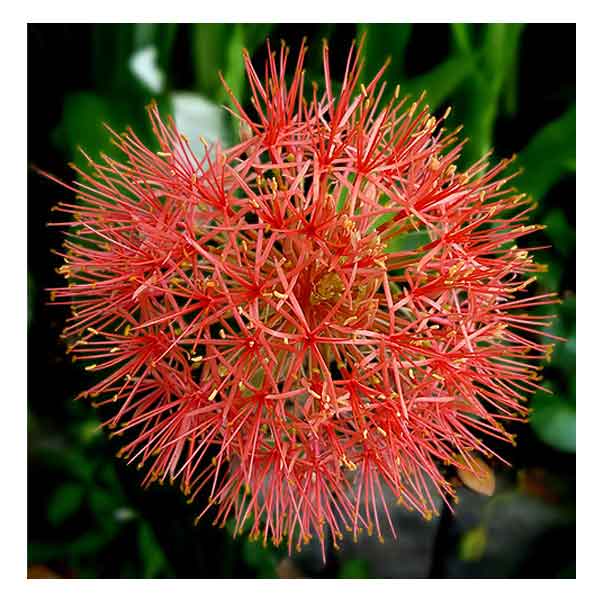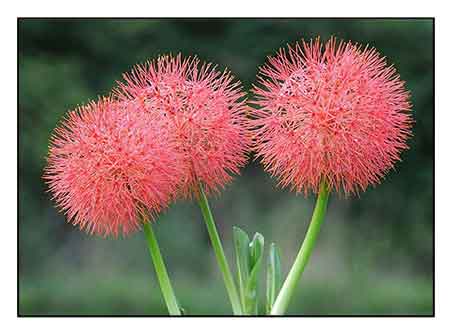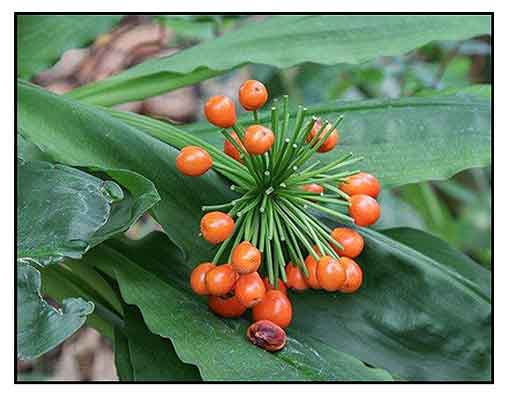 Gen info Gen info
- Etymology: The genus name Scadoxus is a concatenation of Greek words 'sciadion' meaning parasol or umbel, and "doxa" meaning 'glorious'. The species epithet "multiflorus" derives from Latin, meaning "many flowers."
- The subspecies 'katharinae'
honors the English botanist collector and painter Katharine Saunders (1824-1901).
Botany
Scadoxus multiflorus grows from a "rhizomatous bulb", i.e. a bulb which also produces rhizomes (modified underground stems). The leaves and flower may appear together or the leaves may be produced later. The bases of the leaves, the stalks or petioles, are tightly wrapped together to form a pseudostem or false stem, 5–60 cm (2–24 in) long. The flowers are produced in an umbel at the top of a leafless stem (scape), 12–75 cm (5–30 in) long. Both the pseudostem and the scape are often covered with reddish brown to dark violet spots. The bracts under the umbel soon wither. The umbel of flowers is more-or-less globe shaped, with from 10 to 200 individual flowers. Each flower has a stalk (pedicel) typically 15–45 mm (0.6–1.8 in) long. The tepals, filaments of the stamens and the style are all scarlet, fading to pink. The bases of the tepals are fused to form a cylinder-shaped tube, 4–26 mm (0.2–1.0 in) long; the free ends of the tepals are 12–32 mm (0.5–1.3 in) long, narrow and spreading. The fruit is a berry, 5–10 mm (0.2–0.4 in) across. (2)
Distribution
- Cultivated; not naturalized.
- Grown as an ornamental for its brilliantly colored and spectacular flower heads.
- Native range is Tropical and S. Africa to SW Arabian Peninsula. A bulbous geophyte that grows primarily inn the subtropical biome. (1)
 Constituents Constituents
- Phytochemical screening of aerial parts yielded alkaloids, glycosides, tannins, saponins, and flavonoids. (see study below) (5)
- Phytochemical screening yielded alkaloids+++, cardiac glycosides++. flavonoids+++, saponins+++, tannins+++, terpenoids++.
- GC/MS study of bulbs for alkaloids yielded montanine 92%, undalatine 8%.
Properties
- Poisonous / Irritant: All parts of the plant are poisonous due to a toxic substance called lycosine and other alkaloids. Plant sap also reported to cause skin irritation, swelling of lips and tongue, and mild stomach upset (salivation, nausea, vomiting and diarrhea). Washing of hands advised after handling of the plant.
(Dr. Mahadeswara Swamy)
Parts used
Leaves, aerial parts.
Uses
Folkloric
- No reported folkloric medicinal use in the Philippines.
- In Senegal, used for treatment of heart failure. In India, used for colds and asthma. (3)
- In Guinea and northern Nigeria, bulbs used to treat dropsy, scabies, and poorly healing wounds. (6)
- In West Tropical Africa, sap used for ear treatment; as vermifuge and lactation stimulant. In Nigeria, used as stimulant in debility. In Ivory coast, crushed plant applied in topical frictions to weakly children. In Taganyika, dried bulb applied over scarifications on breasts to promote milk flow; bulb decoction taken to treat hookworm disease; sap instilled into ear for earache. (7)
- Bulbs used for snakebite; pounded leaves for diarrhea and dysentery.
- In Yemen, paste made from roots applied on the skin of leishmaniasis patients.
(8)
Others
- Poison: Used as component of arrow poisons and fishing poisons. Twenty-five gm of leaf or bulb is sufficient to kill a sheep or goat. (3) Goats and sheep graze on the plant when other plants are scarce. The leaves seem to have the same toxic effects as the bulb. (6) Hemanthine, an amorphous alkaloid, toxic to animals has been reported.
- Veterinary: Used as a lubricant for cows at parturition. (3) Sap used to hasten calving when rubbed onto the groin of a cow. (7)
- Superstition: Inn South Africa, used to make love charm emetics, which men take as a cleansing and purifying medicine before meeting the loved ones, believing that the love potion makes them more attractive and desirable. (6)
 Studies Studies
• Antimitotic / Cytotoxic / Leaves: Study evaluated the antimitotic and cytotoxic effects of leaf aqueous extract of S. multiflorus in Allium cepa root apical meristem cells. Results showed concentration-dependent growth root growth retardation, decreased mitotic index (MI). The extract induced mitotic, nuclear, and chromosomal abnormalities in A. cepa root tip cells. Results suggest antimitotic and cytotoxic potential of the leaf extract. (4)
• Anti-Inflammatory / Membrane Stabilizing / Anti-Atherothrombotic / Aerial Parts: Study of aqueous crude extract of aerial parts at 0.03-0.15% (v/v) significantly (p<0.05), p<0.01, p<0.001) inhibited protein denaturation, membrane lysis, and clot lysis capacity in a concentration dependent manner. Results suggest potential sources of phytoconstituents for treatment of oxidative stress and inflammatory diseases. (see constituents above) (5)
• Antimycobacterial: In a study for antimycobacterial, antibacterial, and antifungal properties, extract of Scadoxus multiflorus showed strong antimycobacterial activity (zero GUs) against slow growing mycobacteria strains in all concentrations tested. It was also active against M tuberculosis. Results were comparable to isoniazid. The antimicrobial effects were attributed to phytocemical components, particularly alkaloids and flavonoids. (9)
• Anticancer: In vitro anticancer activity of 80% ethanolic extracts of 23 traditionally used Ethiopian medicinal plants were studied using cervical (HeLa) and prostate (PC3) cancer cell lines using MTT calorimetric assay. Scadoxus multiflorus exhibited significant anticancer activity against HeLa cells with IC50 of 14.6 µg/ml. It also significantly inhibited PC3 cell growth with IC50 9.8 µg/ml. The extract exhibited high selectivity index. (10)
• Cholinesterase Inhibitory Activity: Alzheimer's disease is characterized by death of nerve cells in the cerebral cortex, the most common subtype of dementia. Plants of the Amaryllidaceae family are known to synthesize bioactive compounds, Amaryllidaceae alkaloids, which have shown AChE inhibitory activity. Study reports on the GC/Ms investigations of alkaloid extracts from bulbs of Nerine undulata, Scadoxus multiflorus, and Sprekelia formosissima and the inhibitory effects of these extracts on human erythrocytic AChE (HuAChE) and plasma BuChE (HuBuChE). Two alkaloids, montanine and undalatine were identified by GC/MS in S. multiflorus. Extracts of S. multiflorus showed only weak HuAChE inhibition activity, but showed better than standard galanthamine for HuBuChE inhibition activity with IC50 of 54.3 µg/mL. (11)
Availability
Wild-crafted.
|

![]()





 Studies
Studies 